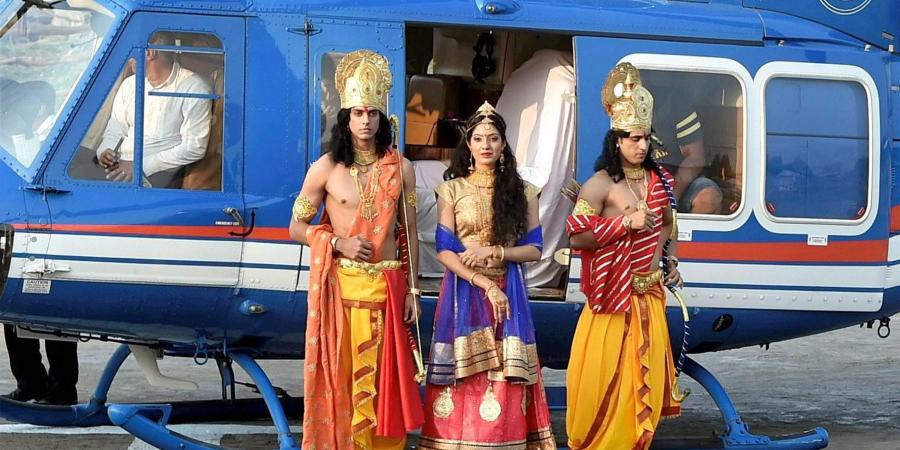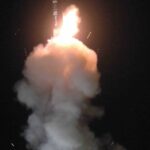
SOURCE: ENS
Communism is a cacophony of contradictions. The comrades abhor religion but in their godless sanctum sanctorum, the unholy Trinity of Marx, Mao and Lenin comprise dialectical divinity. Last week, this discrepancy came to the fore when Khadga Prasad Sharma Oli, the Communist prime minister of Nepal, claimed ownership of Lord Ram. Nepal is the only Hindu nation in the world.
Comrade Oli was attempting a cartographic invasion of Ayodhya, where the first meeting of the Ram Temple Trust was held Saturday. He claimed it lies in Nepal and conferred Nepali citizenship on one of the most sacred of Hindu gods, Lord Ram. Perhaps, China, which is embroiled in Nepali politics, does believe in Ram indeed.
Meanwhile, God’s Own Country lived up to its name after the revered Sri Padmanabhaswamy Temple was restored to Hindus, leaving the Marxist-ruled state government literally red- faced. Oli is the leader of the Communist Party of Nepal-Unified Marxist-Leninist (CPN-UML).
He became the Prime Minister with the help of the Mao-inspired Communist Party of Nepal led by a former Prime Minister, Pushpa Kamal Dahal.
For the past few weeks, Oli’s own comrades have been trying to defenestrate him over Nepal’s tottering economy and excessive proximity with China.
A section of diplomats and the media claim that Dragon Diplomacy, led by the Chinese ambassador to Kathmandu, has temporarily saved Oli’s chair.
But the Comrade himself is insecure about his survival. The avowed atheist’s erroneous epiphany that Ram wasn’t born in Bharat but in the Nepalese part of undivided India is ridiculous.
The hard core Communist is strategising that Ram is his only salvation from daily humiliation. But neither he nor his fellow comrades have ever had a photo op in Nepal’s Pashupatinath temple, which unites the Hindus of Nepal and India.
Yet the prime objective of the tactical alliance between Pakistani green and Chinese red is to divide not only Nepal along ideological lines, but also incite its citizens against India. Comrade Oli is in office on a borrowed time.
He is at the butt end of daily protests from the public and politicians. He has been accusing India of destabilising his government for his close proximity with the Chinese leaders.
However, instead of defending his red romance, the Nepalese PM has surprisingly brought Ram into the narrative. He was quoted by the media as saying, “There is a fierce debate about Ayodhya. In fact, Ayodhya lies in Thori, which is west of Nepal’s Birgunj, and the Pandit who performed Putresthi Yagya (a religious ceremony organised to seek divine blessings to have children) after there were no children from King Dasarath was from Ridi (in Nepal)… Therefore, the child (Ram) is not an Indian. The place (Ayodhya) is not in India either.”
If that wasn’t enough for him to win sympathy at home, he further added: “We have been suppressed culturally. Facts have been twisted. Even today, we believe that Sita was married to an Indian prince, Ram. We gave her not to an Indian, but to the one from Ayodhya. Ayodhya is a village that lies to the west of Birgunj.” Deification of domestic politics appears to be Oli’s short exit route out of the crises.
The diehard despot’s ideological opportunism to save his job was mocked by his own party, Indian scholars and Ram bhakts.
He acquired power not through popular mandate but by external intervention, which brought various factions of Communists together. CPN-UML polled about 33.25 per cent of the votes and got 44 per cent of the seats.
Prachanda, who grabbed 20 per cent seats, extended his support to Comrade Oli. But Oli chose China as his mentor and extended major economic concessions to Chinese companies.
It’s ironic that a section of the Nepalese leadership has charged India with propping up Oli against Prachanda.
In May, Defence Minister Rajnath Singh inaugurated the new 80 km-long road near the Nepal border, which connects the Lipulekh pass near the Chinese border.
In addition to its strategic importance, the highway is one of the quickest road links to reach Mount Kailash.
This project provoked anti-India sentiments in Nepal and helped Oli to consolidate his grip over on domestic politics.
His next step was to escalate tensions against India by changing its own map. For the first time, Nepal officially included large tracts of Indian territory under New Delhi’s control for six decades.
Oli called Parliament and got the new political map approved, which includes Kalapani, Limpiyadhura and Lipulekh of Uttarakhand in Nepal. Oli’s map includes Susta in West Champaran, Bihar as well.
Nepal’s aggressive posturing and growing dependence on China and Pakistan for both commerce and security is causing serious concerns in India.
Though the Hindu DNA of Nepal and India unites both culturally and emotionally, China and Pakistan are attempting a polygamous marriage that could create economic and security problems for India.
Nepal and Pakistan have already given China access to constructing a road that would connect the three nations through hills and valleys important to India.
Nepal also controls over 40 per cent of fresh water supply to certain parts of India. China is egging Nepal on to allow it to construct hydro power plants and dams to restrict water supply from its section of the Himalayan regions. China has made Nepal a key partner in its Belt and Road Initiative (BRI), and plans to invest heavily in Nepal’s infrastructure to boost its global trade.
Indian relations with Nepal have been bumpy in the recent past. Over 5 million people of Nepali origin live in India. Citizens both countries are allowed visa-free visits and use of Indian currency as well.
Due to past diplomatic snafus, India lost its influence over the Nepalese elite and politics. Over the last decade, diplomats with little knowledge about Nepal and its roots were posted in key positions.
The Indian security system failed to keep a tight vigil on the rampaging romance between China and Nepal. Prime Minister Atal Bihari Vajpayee and his eagle-eyed National Security Advisor Brijesh Mishra would always keep a close watch on both diplomatic and political movements in the Nepalese neighbourhood.
When Kathmandu began to misbehave during 2001-2002, Mishra decided to visit Nepal to sort out thorny issues.
Previous to that, the Vajpayee government selectively leaked out a list of Nepali ministers and other influencers with financial and other questionable relations with the Pakistan establishment. The hawks were nowhere to be seen when Mishra landed in Kathmandu.
But the current Indian establishment hasn’t used its powerful machinery to attack anti-India elements by exposing their misdeeds. India’s support for the economic blockade of Nepal in 2015 fuelled anger against India. Subsequently, Nepal’s demand to accept Indian currency after demonetisation was fiercely resisted by North Block mandarins leaving the Himalayan country with a heap of useless paper.
Instead of cementing their ancient cultural affinity by reminding Nepal of Rama and Buddha, Indian diplomats and foreign policy experts have nudged Nepal into China’s lap.
By claiming Rama’s geographical lineage to throw a desperate gauntlet to Bharat, the original birthplace of the god, Comrade Oli has found his spiritual home in the geopolitical sanctuary of red China.
India must affix the Ram baan on its geopolitical Kodanda to shoot down the fishy swayamvaram of China wooing Nepal.






